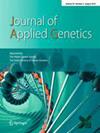摘要
镰刀菌穗腐病(FER)是由真菌病原体疣孢镰刀菌引起的一种全球性病害。玉米对 FER 的抗性是由多基因控制的数量性状。在本研究中,在 2021 年和 2022 年期间,对由近交系 B73(易感性)和 CXS161(高抗性)育成的 159 个品系组成的双倍单倍体(DH)群体进行了接种禾谷镰刀菌的试验。利用 10 K SNP 阵列进行目标测序,对这些品系进行基因分型。结果表明,各环境下的广义遗传力(H2)估计值在 0.659 至 0.871 之间,总体 H2 为 0.805。在使用多单核苷酸多态性(mSNP)构建的遗传图谱中,相邻标记之间的平均遗传长度小于使用 SNP 构建的遗传图谱,而最大遗传长度几乎相同。利用 SNP 构建的遗传图谱在 2 号和 5 号染色体上发现了两个数量性状位点(QTL),分别解释了 7.65% 和 9.58% 的表型变异。利用 mSNP 构建的遗传图谱,确定了 4 个 QTL,解释了 6.04-12.60% 的表型变异。此外,利用单标记分析方法开发了两个竞争性等位基因特异性 PCR(KASP)标记,其中一个 KASP 标记在回交群体中得到了验证,可有效用于鉴定 FER 抗性。总之,在种群规模有限而标记密度较高的情况下,使用 mSNP 构建遗传图谱并不具有优势。然而,mSNP 构建的图谱尽管具有较低的几率(LOD)值,却能识别出更多的次要效应 QTL。Fusarium ear rot (FER) is a global disease caused by the fungal pathogen Fusarium verticillioides. Maize FER resistance is a quantitative trait controlled by polygenes. In this study, a doubled haploid (DH) population involving 159 lines, developed from the inbred lines B73 (susceptible) and CXS161 (highly resistant), was inoculated with Fusarium verticillioides across 4-year-location environment combinations in China during 2021 and 2022. The lines were genotyped using target sequencing with a 10 K SNP array. The results showed that the estimated broad-sense heritability (H2) in each environment ranged from 0.659 to 0.871, with an overall H2 of 0.805. The average genetic length between adjacent markers in the genetic map constructed using multiple single-nucleotide polymorphisms (mSNP) was smaller than that constructed using SNP, whereas the maximal genetic length was almost the same. Using a genetic map constructed with a SNP, two quantitative trait loci (QTL) were identified on chromosomes 2 and 5, which explained 7.65% and 9.58% of the phenotypic variation, respectively. Using the genetic map constructed by mSNP, four QTL were identified, explaining 6.04-12.60% of the phenotypic variation. Moreover, two kompetitive allele-specific PCR (KASP) markers were developed using single-marker analysis methods, with one KASP marker validated across a backcross population that can be effectively used to identify FER resistance. In conclusion, using mSNP for genetic map construction does not confer advantages when the population size is limited and the marker density is high. However, the mSNP-constructed map identified more minor-effect QTL despite possessing a lower likelihood of the odds (LOD) values.

 求助内容:
求助内容: 应助结果提醒方式:
应助结果提醒方式:


